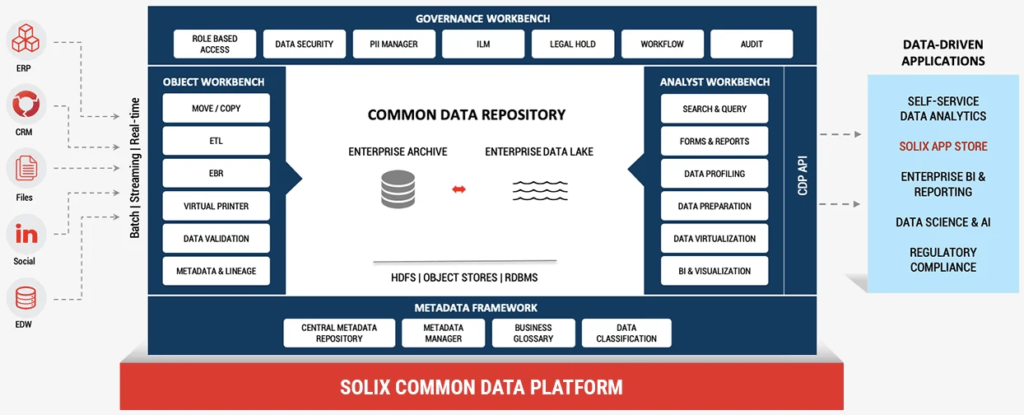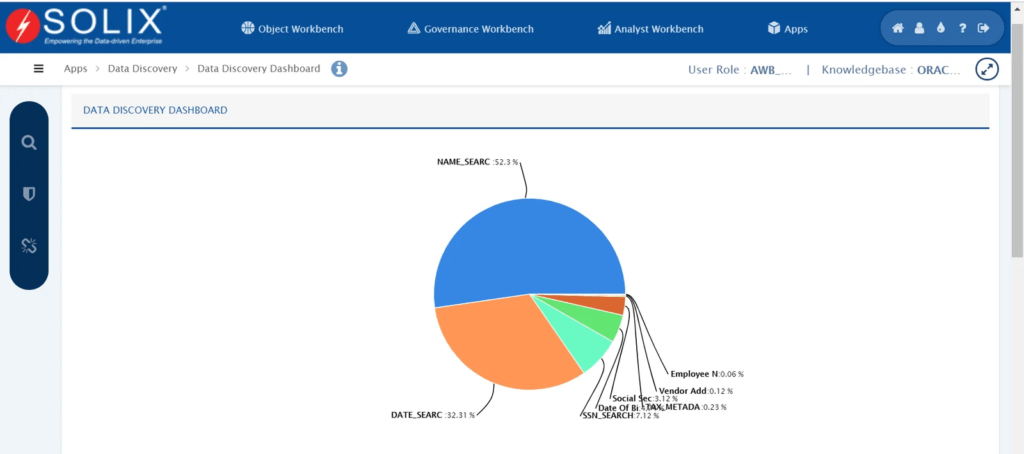Solix Technologies Sensitive Data Discovery
Update solution on May 21, 2020

Solix Common Data Platform (CDP), formerly the Big Data Suite, is a broadly applicable ‘Big Data Application Framework’ that acts as a one stop shop for the management and governance of all of your enterprise data (see Figure 1). To this end, it offers a variety of capabilities, not least of which is sensitive data discovery, provided as part of CDP’s Governance Workbench. The product also provides complementary functionality in the form of data masking, data security, database archiving, test data management, and so forth. It is accessible through the web browser, can be deployed in-cloud, on-prem, or as part of a hybrid solution, and operates at big data scale across both structured and unstructured data. Supported data sources are numerous for relational data, including Oracle, DB2, MSSQL, MySQL and Sybase, and a selection of file formats (JSON, CSV, XML, and several types of documents, spreadsheets and presentations) are supported. However, NoSQL support is currently limited to MongoDB and Hadoop/HDFS.

Fig 01 – Solix Common data Platform architecture

Fig 02 – Discovery dashboard in Solix Common Data Platform
Sensitive data discovery in CDP allows you to identify and locate sensitive data across all of your applications, then catalogue it within a single platform. This not only supports regulatory compliance but provides additional value when used in conjunction with the data security and analytics features contained within CDP. For example, you could leverage CDP to discover your sensitive data, mask or encrypt it, then expose it to your analytics tools via an API. Equally, you could use it to find and protect the sensitive data hidden in your data lake, helping to prevent it from turning into a data swamp. The overall point is that CDP doesn’t just provide sensitive data discovery by its lonesome, but as the first step in addressing an end-to-end use case.

Fig 03 – Data flow diagram in Solix Common Data Platform
The discovery process itself examines both your data and the metadata attached to it. The process begins with the ‘low-hanging fruit’ of metadata matching (for instance, by examining column names) before moving on to the more difficult – but also more thorough – techniques of pattern and value matching within the data as well as master data lookup matching. Moreover, over 25 predefined classification policies are provided out of the box. These are based on compliance requirements such as GDPR, and have been designed to locate any PII, PCI or PHI data elements within your system. You are free to use these policies as-is, customise them, or create your own. The discovery process is fully configurable, and may include sampling to help your users detect false positives. Moreover, sensitive data is always discovered in place: it is never moved by the discovery process. Discovery dashboards and data flow diagrams (as shown in Figures 2 and 3) are provided to visualise your discovery results, and the process itself (as with many of the capabilities in CDP) is available to be run in the cloud as a service.
Solix also provides a dedicated GDPR tool for finding and actioning on all data that is sensitive under GDPR specifically. This will certainly include data discovery, but could also mean purging, archiving, or masking your sensitive data, depending on your requirements.
The sensitive data discovery capabilities offered by Solix are mature and competent. The out of the box policies provided allow you to hit the ground running and receive value very quickly, and this is particularly true in Oracle and PeopleSoft environments, for which dedicated project accelerators are provided, further reducing implementation time and improving ROI. Moreover, the dedicated GDPR tool the company offers provides a relatively easy way of getting your house in order for GDPR. Given that GDPR is a major driver for sensitive data management, this is a significant draw.
One of the other big benefits for CDP is that it is not by any means restricted to sensitive data discovery. On the contrary, it provides a broad range of (sensitive) data management and security capabilities, such as data masking, database archival and application retirement. These naturally pair well with sensitive data discovery. Moreover, CDP is intended as a single, scalable and all-encompassing solution. Not only does it provide a large quantity of data management and security features, it will also deploy those features across a wide range of environments and data sources, notably including big data environments such as data lakes. The only caveat to this, at least in terms of sensitive data discovery, is that its support for NoSQL data sources is relatively limited. That said, within the context of the sensitive data discovery space, it offers as much or more than many of its competitors.
The Bottom Line
Solix CDP offers sensitive data discovery as one feature among many within a broad and highly competent data management suite. Given that sensitive data discovery works most effectively in tandem with other data security and sensitive data management capabilities, this is no bad thing.
Related Company
Connect with Us
Ready to Get Started
Learn how Bloor Research can support your organization’s journey toward a smarter, more secure future."
Connect with us Join Our Community
